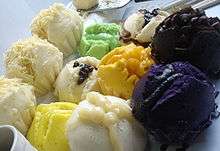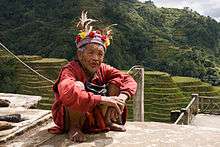Culture of the Philippines
| Part of a series on the |
| Culture of the Philippines |
|---|
 |
| History |
| People |
| Languages |
| Traditions |
| Cuisine |
| Festivals |
| Religion |
| Art |
| Literature |
|
Music and performing arts |
|
Monuments |
|
The culture of the Philippines is a combination of Eastern and Western culture. Before the Spanish colonization of the country, the Philippines' culture was mainly influenced by the indigenous Malay heritage of Southeast Asia.[1] The Spanish Empire then colonized the islands and, after more than three centuries of colonization, Roman Catholicism spread throughout the archipelago and Hispanic influence heavily impacted the country's culture. The Philippines, then being governed from both Mexico and Spain, received a fair bit of Hispanic influence from the regions. For instance, Mexican and Spanish influence can be seen in the country's dance and religion as well as many other aspects of its culture. Then, after being colonized by Spain, the Philippines became a U.S. territory for almost 50 years. Influence from the United States is manifest in the wide use of the English language and in the modern pop culture of present-day Philippines.
The Philippines was first settled by Melanesians; today, although few in numbers, they preserve a very traditional way of life and culture. After them, the Austronesians or more specifically, Malayo-Polynesians, arrived on the islands. Today the Austronesian culture is very evident in the ethnicity, language, food, dance and almost every aspect of the culture. These Austronesians engaged in trading with China, India, Palau, Malay, America, Malaysia, Papua, west Pacific Islander, Indonesian Islands, the Middle East, Borneo, and other places. As a result, those cultures have also left a mark on Filipino culture.[2][3]
Religion
The Philippines is one of the two predominantly Roman Catholic (80.58%) nations in Asia-Pacific, the other being East Timor. From the census in 2014, Christianity consist about 90.07% of the population while Islam is the religion for about 5.57% [4][5] of the population. Those who reported others or none composed 4.37% of the total population of the country.
Before the arrival of the Spaniards and the introduction of Roman Catholicism and Western culture in the 16th century, the indigenous Austronesian people of what is now called the Philippines were adherents of a mixture of shamanistic Animism, Islam, Hinduism and Vajrayana Buddhism.[6]
Architecture

Being a colony of the Spanish Empire for almost 300 years, the Spaniards introduced European colonial architecture to the Philippines. The introduction of Christianity brought European churches, and architecture which subsequently became the center of most towns and cities in the country. The Spaniards also introduced stones as housing and building materials. Spanish colonial architecture can still be seen in centuries-old churches, schools, convents, government buildings and residences around the country. The best collection of Spanish colonial architecture can be found in the walled city of Intramuros in Manila and in the historic town of Vigan. Colonial-era churches are also on the best examples and legacies of Spanish Baroque architecture in the Philippines. Historic provinces such as Ilocos Norte, Pampanga, Bulacan, Cavite, Batangas, Laguna, Quezon and Iloilo also boasts colonial-era churches and houses.
In the past, before the Spanish colonization, the Nipa hut (Bahay Kubo) was the common form of housing among the native Filipinos. It is characterized by use of simple materials such as bamboo and coconut as the main sources of wood. Cogon grass, Nipa palm leaves and coconut fronds are used as roof thatching. Most primitive homes are built on stilts due to frequent flooding during the rainy season. Regional variations include the use of thicker, and denser roof thatching in mountain areas, or longer stilts on coastal areas particularly if the structure is built over water. The architecture of other indigenous peoples may be characterized by an angular wooden roofs, bamboo in place of leafy thatching and ornate wooden carvings.
The University of Santo Tomas Main Building in Manila is an example of Renaissance Revival architecture. The building was built on 1924 and was completed at 1927. The building, designed by Fr. Roque Ruaño, O.P., is the first earthquake-resistant building in the Philippines.[7] Islamic and other Asian architecture can also be seen depicted on buildings such as mosques and temples. Contemporary architecture has a distinctively Western style although pre-Hispanic housing is still common in rural areas. American style suburban-gated communities are popular in the cities, including Manila, and the surrounding provinces.
- Architecture of the Philippines


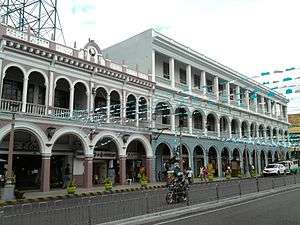 Neoclassical buildings in Calle Real, Iloilo
Neoclassical buildings in Calle Real, Iloilo
Visual Arts
Painting
Early Filipino painting can be found in red slip (clay mixed with water) designs embellished on the ritual pottery of the Philippines such as the acclaimed Manunggul Jar. Evidence of Philippine pottery-making dated as early as 6,000 BC has been found in Sanga-sanga Cave, Sulu and Laurente Cave, Cagayan. It has been proven that by 5,000 BC, the making of pottery was practiced throughout the country. Early Filipinos started making pottery before their Cambodian neighbors, and at about the same time as the Thais as part of what appears to be a widespread Ice Age development of pottery technology.
Further evidence of painting is manifest in the tattoo tradition of early Filipinos, whom the Portuguese explorer referred to as Pintados or the 'Painted People' of the Visayas.[8][9] Various designs referencing flora and fauna with heavenly bodies decorate their bodies in various colored pigmentation. Perhaps, some of the most elaborate painting done by early Filipinos that survive to the present day can be manifested among the arts and architecture of the Maranao who are well known for the Naga Dragons and the Sarimanok carved and painted in the beautiful Panolong of their Torogan or King's House.
Filipinos began creating paintings in the European tradition during 17th-century Spanish period. The earliest of these paintings were Church frescoes, religious imagery from Biblical sources, as well as engravings, sculptures and lithographs featuring Christian icons and European nobility. Most of the paintings and sculptures between the 19th and 20th centuries produced a mixture of religious, political, and landscape art works, with qualities of sweetness, dark, and light.
Early modernist painters such as Damián Domingo was associated with religious and secular paintings. The art of Juan Luna and Félix Hidalgo showed a trend for political statement. The first Philippine national artist Fernando Amorsolo used post-modernism to produce paintings that illustrated Philippine culture, nature and harmony. While other artist such as Fernando Zóbel used realities and abstract on his work. In the 1980s, Elito Circa, popularly known as Amangpintor, gained recognition. He uses his own hair to make his own paintbrushes and signs his painting using his own blood on the right side corner. He developed his own styles without professional training or guidance from masters.
- Popular paintings of the Philippines
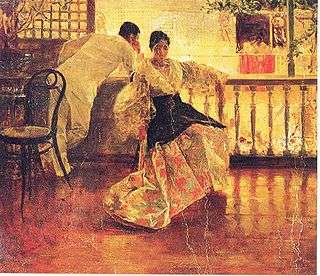 Tampuhan
Tampuhan
by Juan Luna
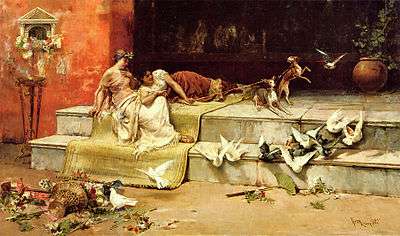 Las Damas Romanas
Las Damas Romanas
by Juan Luna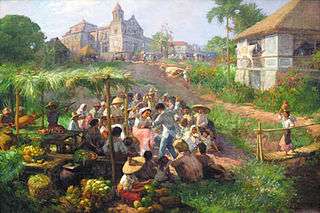 Antipolo
Antipolo
by Fernando Amorsolo_by_Felix_Ressureccion_Hidalgo_1884.jpg)
Indigenous art

The Itneg people are known for their intricate woven fabrics. The binakol is a blanket which features designs that incorporate optical illusions. Woven fabrics of the Ga'dang people usually have bright red tones. Their weaving can also be identified by beaded ornamentation. Other peoples such as the Ilongot make jewelry from pearl, red hornbill beaks, plants, and metals. Some indigenous materials are also used as a medium in different kinds of art works especially in painting by Elito Circa, a folk artist of Pantabangan and a pioneer for using indigenous materials, natural raw materials including human blood. Many Filipino painters were influenced by this and started using these materials such as extract from onion, tomato, tuba, coffee, rust, molasses and other materials available anywhere as paint. The Lumad peoples of Mindanao such as the B'laan, Mandaya, Mansaka and T'boli are skilled in the art of dyeing abaca fiber. Abaca is a plant closely related to bananas, and its leaves are used to make fiber known as Manila hemp. The fiber is dyed by a method called ikat. Ikat fiber are woven into cloth with geometric patterns depicting human, animal and plant themes.
A technique combining ancient Oriental and European art process. Considered lost art and highly collectible art form. Very few known art pieces existed today. The technique was practiced by the indigenous people of Samar Island between early 1600 and late 1800 A.D. Kut-kut is an exotic Philippine art form based on early century techniques—sgraffito, encaustic and layering. The merging of these ancient styles produces a unique artwork characterized by delicate swirling interwoven lines, multi-layered texture and an illusion of three-dimensional space.
Islamic art
Islamic art in the Philippines have two main artistic styles. One is a curved-line woodcarving and metalworking called okir, similar to the Middle Eastern Islamic art. This style is associated with men. The other style is geometric tapestries, and is associated with women. The Tausug and Sama–Bajau exhibit their okir on elaborate markings with boat-like imagery. The Marananaos make similar carvings on housings called torogan. Weapons made by Muslim Filipinos such as the kampilan are skillfully carved.
Performing arts
Music

The early music of the Philippines featured a mixture of Indigenous, Islamic and a variety of Asian sounds that flourished before the European and American colonization in the 16th and 20th centuries. Spanish settlers and Filipinos played a variety of musical instruments, including flutes, guitar, ukulele, violin, trumpets and drums. They performed songs and dances to celebrate festive occasions. By the 21st century, many of the folk songs and dances have remained intact throughout the Philippines. Some of the groups that perform these folk songs and dances are the Bayanihan, Filipinescas, Barangay-Barrio, Hariraya, the Karilagan Ensemble, and groups associated with the guilds of Manila, and Fort Santiago theatres. Many Filipino musicians have risen prominence such as the composer and conductor Antonio J. Molina, the composer Felipe P. de Leon, known for his nationalistic themes and the opera singer Jovita Fuentes.
Modern day Philippine music features several styles. Most music genres are contemporary such as Filipino rock, Filipino hip hop and other musical styles. Some are traditional such as Filipino folk music.
Dancing

Philippine folk dances include the Tinikling and Cariñosa. In the southern region of Mindanao, Singkil is a popular dance showcasing the story of a prince and princess in the forest. Bamboo poles are arranged in a tic-tac-toe pattern in which the dancers exploit every position of these clashing poles.[10][11]
Literature
The Philippine literature is a diverse and rich group of works that has evolved throughout the centuries. It had started with traditional folktales and legends made by the ancient Filipinos before Spanish colonization. The main themes of Philippine literature focus on the country’s pre-colonial cultural traditions and the socio-political histories of its colonial and contemporary traditions. The literature of the Philippines illustrates the Prehistory and European colonial legacy of the Philippines, written in both Indigenous and Hispanic writing system. Most of the traditional literatures of the Philippines were written during the Mexican and Spanish period. Philippine literature is written in Spanish, English, or any indigenous Philippine languages.
Some of the well known work of literature were created from the 17th to 19th century. The Ibong Adarna is a famous epic about an magical bird which was claimed to be written by José de la Cruz or "Huseng Sisiw".[12] Francisco Balagtas is one of the country's prominent Filipino poets, he is named as one of the greatest Filipino literary laureates for his contributions in Philippine literature. His greatest work, the Florante at Laura is considered as his greatest work and one of the masterpieces of Philippine literature. Balagtas wrote the epic during his imprisonment.[13]José Rizal, the national hero the country, wrote the novels Noli Me Tángere (Touch Me Not) and El Filibusterismo (The Filibustering, also known as The Reign of Greed).
Cinema and media
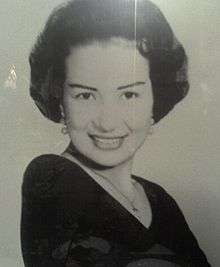
The formative years of Philippine cinema, starting from the 1930s, were a time of discovery of film as a new medium of expressing artworks. Scripts and characterizations in films came from popular theater shows and Philippine literature.
The advent of the cinema of the Philippines can be traced back to the early days of filmmaking in 1897 when a Spanish theater owner screened imported moving pictures.
In the 1940s, Philippine cinema brought the consciousness of reality in its film industry. Nationalistic films became popular, and movie themes consisting primarily of war and heroism and proved to be successful with Philippine audiences.
The 1950s saw the first golden age of Philippine cinema,[14][15] with the emergence of more artistic and mature films, and significant improvement in cinematic techniques among filmmakers. The studio system produced frenetic activity in the Philippine film industry as many films were made annually and several local talents started to gain recognition abroad. Award-winning filmmakers and actors were first introduced during this period. As the decade drew to a close, the studio system monopoly came under siege as a result of labor-management conflicts. By the 1960s, the artistry established in the previous years was in decline. This era can be characterized by rampant commercialism in films.
The 1970s and 1980s were considered turbulent years for the Philippine film industry, bringing both positive and negative changes. The films in this period dealt with more serious topics following the Martial law era. In addition, action, western, drama, adult and comedy films developed further in picture quality, sound and writing. The 1980s brought the arrival of alternative or independent cinema in the Philippines.
The 1990s saw the emerging popularity of drama, teen-oriented romantic comedy, adult, comedy and action films.[15]
The Philippines, being one of Asia's earliest film industry producers, remains undisputed in terms of the highest level of theater admission in Asia. Over the years, however, the Philippine film industry has registered a steady decline in movie viewership from 131 million in 1996 to 63 million in 2004.[16][17] From a high production rate of 350 films a year in the 1950s, and 200 films a year during the 1980s, the Philippine film industry production rate declined in 2006 to 2007.[16][17] The 21st century saw the rebirth of independent filmmaking through the use of digital technology and a number of films have once again earned nationwide recognition and prestige.
With the high rates of film production in the past, several movie artists have appeared in over 100+ roles in Philippine Cinema[18] and enjoyed great recognition from fans and moviegoers.
Cuisine
Filipinos cook a variety of foods influenced by Western, Pacific Islander, and Asian cuisine. The Philippines is considered a melting pot of the West and Asia.
The Spanish colonizers and friars in the 16th century brought with them produce from the Americas such as chili peppers, tomatoes, corn, potatoes, and the method of sautéing with garlic and onions. Eating out is a favorite Filipino pastime. A typical Pinoy diet consists at most of six meals a day; breakfast, snacks, lunch, snacks, dinner, and again a midnight snack before going to sleep. Rice is a staple in the Filipino diet, and is usually eaten together with other dishes. Filipinos regularly use spoons together with forks and knives. Some also eat with their hands, especially in informal settings, and when eating seafood. Rice, corn, and popular dishes such as adobo (a meat stew made from either pork or chicken), lumpia (meat or vegetable rolls), pancit (a noodle dish), and lechón baboy (roasted pig) are served on plates.
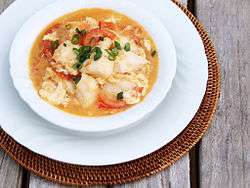
Other popular dishes brought from Spanish and Southeast Asian influences include afritada, asado, chorizo, empanadas, mani (roasted peanuts), paksiw (fish or pork, cooked in vinegar and water with some spices like garlic and pepper), pan de sal (bread of salt), pescado frito (fried or grilled fish), sisig, torta (omelette), kare-kare (ox-tail stew), kilawen, pinakbet (vegetable stew), pinapaitan, and sinigang (tamarind soup with a variety of pork, fish, or prawns). Some delicacies eaten by some Filipinos may seem unappetizing to the Western palate include balut (boiled egg with a fertilized duckling inside), longanisa (sweet sausage), and dinuguan (soup made from pork blood).
Popular snacks and desserts such as chicharon (deep fried pork or chicken skin), halo-halo (crushed ice with evaporated milk, flan, sliced tropical fruit, and sweet beans), puto (white rice cakes), bibingka (rice cake with butter or margarine and salted eggs), ensaymada (sweet roll with grated cheese on top), polvoron (powder candy), and tsokolate (chocolate) are usually eaten outside the three main meals. Popular Philippine beverages include San Miguel Beer, Tanduay Rhum, coconut arrack, and tuba.
Every province has its own specialty and tastes vary in each region. In Bicol, for example, foods are generally spicier than elsewhere in the Philippines. Patis (fish sauce), suka (vinegar), toyo (soy sauce), bagoong, and banana ketchup are the most common condiments found in Filipino homes and restaurants.
Western fast food chains such as McDonald's, Wendy's, KFC, and Pizza Hut are a common sight in the country. Local food chains such as Jollibee, Goldilocks Bakeshop, Mang Inasal and Chowking are also popular and have successfully competed against international fast food chains.[19][20]
Education
Education in the Philippines has been influenced by Western and Eastern ideology and philosophy from the United States, Spain, and its neighbouring Asian countries. Philippine students enter public school at about age four, starting from nursery school up to kindergarten. At about seven years of age, students enter elementary school (6 to 9 years) this include Grade 7 to Grade 10 as Junior High School then after they graduate. Since the Philippines has already implemented the K-12 system , students will enter SHS or Senior High School, a 2 year course, to be able to prepare College life with their chosen track such as ABM (Accountancy Business Management), STEM (Science, Technology, Engineering and Mathematics) and HUMSS (Humanities and Social Sciences) other tracks are included like TECH-VOC (Technical Vocational). Students can make a choice if they will take the college entrance examinations (CEE) for which they enter college or university (3 to 5 years) or find a work after they graduate on Senior High School.
Other types of schools in the country include Private school, Preparatory school, International school, Laboratory high school, and Science high school. Of these schools, private Catholic schools are the most famous. Catholic schools are preferred in the Philippines due to their religious beliefs. Most Catholic schools are co-ed. The uniforms of Catholic schools usually have an emblem along with the school colors.
The school year in the Philippines starts in June and ends in March, with a two-month summer break from April to May, two-week semestral break in October and Christmas and New Year's holidays. Changes are currently being made to the system and some universities have copied the Westernized academic calendar and now start the school year in August.
In 2005, the Philippines spent about US$138 per pupil compared to US$1,582 in Singapore, US$3,728 in Japan, and US$852 in Thailand.[21][22]
Sports
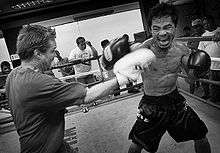
Arnis, a form of martial arts, is the national sport in the Philippines.[23] Among the most popular sports include basketball, boxing, football, billiards, chess, ten-pin bowling, volleyball, horse racing, Sepak Takraw and cockfighting. Dodgeball, badminton and Tennis are also popular.
Filipinos have gained international success in sports. These are boxing, football, billiards, ten-pin bowling, and chess. Popular sport stars include Manny Pacquiao, Flash Elorde, and Francisco Guilledo in boxing, Paulino Alcántara in football, Carlos Loyzaga, Robert Jaworski, and Ramon Fernandez in basketball, Efren Reyes and Francisco Bustamante in billiards, Rafael Nepomuceno in ten-pin bowling, Eugene Torre and Renato Naranja in chess, and Mark Munoz in MMA.
The Palarong Pambansa, a national sports festival, has its origin in an annual sporting meet of public schools that started in 1948. Private schools and universities eventually joined the national event, which became known as the "Palarong Pambansa" in 1976. It serves as a national Olympic Games for students, competing at school and national level contests. The year 2002 event included football, golf, archery, badminton, baseball, chess, gymnastics, tennis, softball, swimming, table tennis, taekwondo, track and field, and volleyball.
Martial arts

There are several forms of Filipino martial arts that originated in the Philippines (similar to how Silat is the martial arts practiced in Asia) including Eskrima (weapon-based fighting, also known as Arnis and in the West sometimes as Kali), Panantukan (empty-handed techniques), and Pananjakman (the boxing component of Filipino martial arts).
Traditional Filipino games
One Traditional Filipino game is luksong tinik. A very popular game to Filipino children where one has to jump over the tinik and cross to the other side unscathed.[24] Other traditional Filipino games include yo-yo, piko, patintero, bahay kubo, pusoy, and sungka. Tong-its is a popular gambling game. Individuals play the game by trying to get rid of all the cards by choosing poker hands wisely. Sungka is played on a board game using small sea shells in which players try to take all shells. The winner is determined by who has the most shells at the point when all small pits become empty.[25] Filipinos have created toys using insects such as tying a beetle to string, and sweeping it circular rotation to make an interesting sound. The "Salagubang gong" is a toy described by Charles Brtjes, an American entomologist, who traveled to Negros and discovered a toy using beetles to create a periodic gong effect on a kerosene can as the beetle rotates above the contraption.[26] Piko is a Philippine version of the game hopscotch. Children will draw a sequence rectangles using chalk on the ground. With various level of obstacle on each rectangle, children will compete against one another or in a team. Players use pamato; usually a flat stone, slipper or anything that could be toss easily.
Indigenous groups
The Indigenous peoples of the Philippines consist of a large number of Austronesian ethnic groups. They are the descendants of the original Austronesian inhabitants of the Philippines, that settled in the islands thousands of years ago, and in the process have retained their Indigenous customs and traditions.[27]
In 1990, more than 100 highland peoples constituted approximately three percent of the Philippine population. Over the centuries, the isolated highland peoples have retained their Indigenous cultures. The folk arts of these groups were, in a sense, the last remnants of Indigenous traditions that flourished throughout the Philippines before the Islamic and Spanish contacts.
The highland peoples are a primitive ethnic group like other Filipinos, although they did not, as a group, have as much contact with the outside world. These peoples displayed a variety of native cultural expressions and artistic skills. They showed a high degree of creativity such as the production of bowls, baskets, clothing, weapons and spoons. These peoples ranged from various groups of Igorot people, a group that includes the Bontoc, Ibaloi, Ifugao, Isneg, Kalinga and Kankana-ey, who built the Rice Terraces thousands of years ago. They have also covered a wide spectrum in terms of their integration and acculturation with Christian Filipinos. Other Indigenous peoples include the Lumad peoples of the highlands of Mindanao. These groups have remained isolated from Western and Eastern influences.
Philippine diaspora
An Overseas Filipino is a person of Filipino origin, who lives outside of the Philippines. This term is applied to people of Filipino ancestry, who are citizens or residents of a different country. Often, these Filipinos are referred to as Overseas Filipino Workers.
There are about 11 million overseas Filipinos living worldwide, equivalent to about 11 percent of the total population of the Philippines.[28]
Each year, thousands of Filipinos migrate to work abroad through overseas employment agencies and other programs. Other individuals emigrate and become permanent residents of other nations. Overseas Filipinos often work as doctors, nurses, accountants, IT professionals, engineers, architects,[29] entertainers, technicians, teachers, military servicemen, students, caregivers, domestic helpers, and household maids.
International employment includes an increasing number of skilled Filipino workers taking on unskilled work overseas, resulting in what has been referred to as brain drain, particularly in the health and education sectors. Also, the employment can result in underemployment, for example, in cases where doctors undergo retraining to become nurses and other employment programs. The Moro Muslim, Lumad, and Igorot peoples resisted Spanish rule unlike the Filipinos who submitted to the Americans and Spanish such as the Tagalog. The mixed Moro and Igorot Joseph Allen Ruanto-Ramirez wrote on how these Filipinos suffer from "Bahag syndrome" trying to compensate for their colonized mentality and culture by adopting Igorot clothing and faux Igorot tattoos.[30][31] Eric John Ramos David authored the book Brown Skin, White Minds: Filipino-/American Postcolonial Psychology (with Commentaries) on this topic.[32][33] E. J. R. David authored the book Filipino-American Postcolonial Psychology: Oppression, Colonial Mentality, and Decolonization.[34] The King Philip II colonial derived name "Philippines" is held in scorn by Moro Muslims and instead Maharlika is favored as a better native origin name.[35]
Festivals
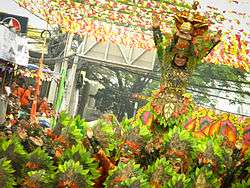

Festivals in the Philippines, locally known as fiestas, originated dating back to the Spanish colonial period when the Spaniards introduced Christianity to the country. Most Philippine towns and cities has a patron saint assigned to each of them. Fiestas in the Philippines serve as either religious, cultural, or both. These festivals are held to honor the patron saint or to commemorate history and culture, such as promoting local products and celebrate a bountiful harvest. Fiestas can be categorized by Holy Masses, processions, parades, theatrical play and reenactments, religious or cultural rituals, trade fairs, exhibits, concerts, pageants and various games and contests.
| Month | Festival | Place |
|---|---|---|
| January | Ati-Atihan | Kalibo, Aklan |
| Sinulog | Cebu | |
| Dinagyang | Iloilo | |
| Coconut | San Pablo City, Laguna | |
| Hinugyaw | Koronadal, South Cotabato | |
| February | Panagbenga | Baguio |
| Kaamulan | Bukidnon | |
| Paraw Regatta | Iloilo City and Guimaras | |
| Pamulinawen | ilocos | |
| March | Pintados de Passi | Passi City, Iloilo |
| Araw ng Dabaw | Davao | |
| Kariton | Licab, Nueva Ecija | |
| April | Moriones | Marinduque |
| Sinuam | San Jose, Batangas | |
| Aliwan | Pasay | |
| May | Magayon | Albay |
| Pahiyas | Lucban, Quezon | |
| Sanduguan | Calapan City, Oriental Mindoro | |
| Butwaan | Butuan City | |
| June | Baragatan | Palawan |
| Sangyaw | Tacloban City | |
| Pista Y Ang Kagueban | Puerto Princesa City, Palawan | |
| July | T'nalak | Koronadal, South Cotabato |
| August | Kadayawan | Davao |
| Pavvu-rulun | Tuguegarao City | |
| September | Peñafrancia | Naga, Bicol |
| Padul-ong | Borongan City, Eastern Samar | |
| Bonok-Bonok | Surigao City | |
| Banigan | Basey, Samar | |
| Diyandi | Iligan City | |
| October | Fiesta Pilar | Zamboanga City |
| Masskara | Bacolod | |
| Buglasan | Oriental Negros | |
| November | Itik | Victoria, Laguna |
| December | Paru-Paru | Dasmariñas, Cavite |
Holidays
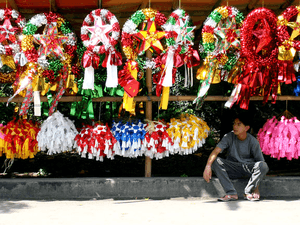
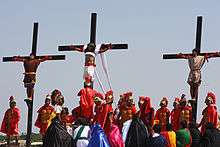
Regular holidays
| Date (Gregorian Calendar) | Filipino language | English language |
|---|---|---|
| January 1 | Araw ng Bagong Taon | New Year's Day |
| March–April | Mahal na Araw including Biyernes Santo and Huwebes Santo | Holy Week including Good Friday and Maundy Thursday |
| April 9 | Araw ng Kagitingan | Day of Valour |
| May 1 | Araw ng mangagawa | Labour Day |
| June 12 | Araw ng Kalayaan | Independence Day |
| August 27 | Araw ng mga Bayani | National Heroes' Day |
| November 30 | Araw ni Bonifacio | Bonifacio Day |
| December 24 | Bisperás ng Pasko | Christmas Eve |
| December 25 | Araw ng Pasko | Christmas |
| December 30 | Araw ni Rizal | Rizal Day |
Special holidays
| Date (Gregorian Calendar) | Filipino language | English language |
|---|---|---|
| January–February | Bagong Taong Pang Intsik | Chinese New Year |
| February 25 | Anibersaryo ng Rebolusyon ng Lakas ng mga Tao | People Power Revolution Anniversary |
| August 21 | Araw ni Ninoy Aquino | Ninoy Aquino Day |
| November 1 | Araw ng mga Santo | All Saints Day |
| November 2 | Araw ng mga Kaluluwa | All Souls' Day |
| December 31 | Bisperás ng Bagong Taón | New Year's Eve |
See also
- Arts of the Philippines
- Cultural pluralism
- Filipino values
- Hispanic culture in the Philippines
- List of museums in the Philippines
Further reading
- Kathleen Melissa Martinez (2007). FINDING A HOME FOR FILIPINO-AMERICAN DUAL CITIZENS: MEMBERSHIP AND THE FILIPINO NATIONAL IDENTITY (PDF) (Master of Arts in Communication, Culture and Technology thesis). Georgetown University. Archived from the original (PDF) on 2011-10-05.
References
- ↑ Baringer, Sally E. [c. 2006]. "The Philippines". In Countries and Their Cultures. Advameg Inc. Retrieved December 20, 2009 from www.everyculture.com.
- ↑ "Going Banana". ThePhilippines.ph.
- ↑ "The Cultural Influences of India, China, Arabia, and Japan". Philippine Almanac. Archived from the original on 2012-07-01.
- ↑ http://web0.psa.gov.ph/sites/default/files/2014%20PIF.pdf
- ↑ Philippines in Figures 2014. National Statistics Office. 2014. pp. 29–34.
- ↑ Carolyn Brewer (2004). Shamanism, Catholicism, and gender relations in colonial Philippines, 1521-1685. Ashgate Publishing. p. xvii. ISBN 978-0-7546-3437-9.
- ↑ "Main Building". UST.edu.ph. Retrieved 2009-12-04.
- ↑ "Islas de los Pintados: The Visayan Islands". Archived from the original on 2011-05-26.
- ↑ Francisco Alzina (1668). Historias de las Islas el Indios de Bisaias.
The Bisayans are called Pintados because they are in fact so, not by nature although they are well-built, well-featured and white, but by painting their entire bodies from head to foot as soon as they are young men with strength and courage enough to endure the torture of painting. In the old days, they painted themselves when they had performed some brave deed. They paint themselves by first drawing blood with pricks from a very sharp point, following the design and lines previously marked by the craftsmen in the art, and then over the fresh blood applying an indelible black powder. They do not paint the whole body at one time, but part by part, so that the painting takes many days to complete. In the former times they had to perform a new feat of bravery for each of the parts that were to be painted. The paintings are very elegant, and well proportioned to the members and parts where they are located. I used to say there, captivated and astonished by the appearance of one of these, that if they brought it to Europe a great deal of money could be made by displaying it. Children are not painted. The women paint the whole of one hand and a part of the other.
- ↑ "Hot Spots Filipino Cultural Dance - Singkil".
- ↑ "Guide to Philippine Cultural and Folk Dances". philippinesculturalfolkdances.blogspot.com.
- ↑ "Ibong Adarna in the year 2014". philstar.com.
- ↑ "Philippine Heroes - Francisco Baltazar Balagtas y Dela Cruz (1788-1862)". Etravel Pilipinas. Retrieved 11 March 2014.
- ↑ "Is the Curtain Finally Falling on the Philippine Kovie Industry?". philnews.com. Retrieved January 25, 2009.
- 1 2 "Aenet: Philippine Film History". aenet.org. Retrieved January 22, 2009.
- 1 2 Grafilo, John (May 6, 2008). "Cannes entry puts spotlight on Philippine indie films". Top News Light Reading.
- 1 2 Conde, Carlos H (February 11, 2007). "A bleak storyline for the Filipino film industry". International Herald Tribune.
- ↑ "Filipino Culture - Most Exposed Filipino Movie Artists". thepinoywarrior.com.
- ↑ "The Jollibee Phenomenon". Jollibee Inc. Archived from the original on June 23, 2007. Retrieved January 9, 2008.
- ↑ Conde, Carlos H. (May 31, 2005). "Jollibee stings McDonald's in Philippines". The New York Times. Retrieved January 5, 2010.
- ↑ "Saving Philippine education". mb.com.ph. Archived from the original on February 10, 2009. Retrieved August 19, 2008.
- ↑ "Differences in Culture in South East Asia". http://aroundtheworldinaday.com. Retrieved 15 July 2014. External link in
|website=(help) - ↑ "Republic Act No. 9850 : AN ACT DECLARING ARNIS AS THE NATIONAL MARTIAL ART AND SPORT OF THE PHILIPPINES". Lawphil.net. December 11, 2009.
- ↑ "Luksong Tinik - About the Philippines". thepinoywarrior.com.
- ↑ "Mancala Games /Sungka".
- ↑ Brtjes, Charles. "THE SALAGUBONG GONG, A FILIPINO INSECT TOY" (PDF). Harvard University.
- ↑ "National Commission of Indigenous People". ncip.gov.ph. Retrieved August 30, 2008.
- ↑ Yvette Collymore (June 2003). "Rapid Population Growth, Crowded Cities Present Challenges in the Philippines". Population Reference Bureau. Retrieved 2007-08-14.
An estimated 10 percent of the Philippine population, or nearly 8 million people, are overseas Filipino workers distributed in 182 countries, according to POPCOM. That is in addition to the estimated 3 million migrants who work illegally abroad
- ↑ GABRIELA Network USA (19 July 2004). "[Info-Bureau] FW: STATEMENT ON FILIPINO HOSTAGE". Philippine Women Centre of BC — requoted by lists.ilps-news.com Mailing Lists. Retrieved 2007-03-21.
- ↑ Ruanto-Ramirez, Joseph Allen (2013-12-04). Locating Their Penis: Pilipino American College Male Performativity, Sexuality, and the ‘Bahag Syndrome’ (CALIFORNIA STATE UNIVERSITY SAN MARCOS THESIS SIGNATURE PAGE THESIS SUBMITTED IN PARTIAL FULLFILLMENT OF THE REQUIREMENTS FOR THE DEGREE MASTER OF ARTS IN SOCIOLOGICAL PRACTICE).Ruanto-Ramirez, Joseph Allen (November 26, 2013). Locating Their Penis: Pilipino American College Male Performativity, Sexuality, and the ‘Bahag Syndrome’ (CALIFORNIA STATE UNIVERSITY SAN MARCOS THESIS SIGNATURE PAGE THESIS SUBMITTED IN PARTIAL FULLFILLMENT OF THE REQUIREMENTS FOR THE DEGREE MASTER OF ARTS IN SOCIOLOGICAL PRACTICE).https://prezi.com/yzbiwii8yxbo/locating-their-penis-pilipino-american-college-male-perfor/ https://prezi.com/okq_kxw7swyc/copy-of-locating-their-penis-pilipino-american-college-male-perfor/ https://docs.askiven.com/8-bahag.html https://oatd.org/oatd/search?q=subject%3A%28Pilipino%29&pagesize=30 http://hdl.handle.net/10211.8/546 http://csusm-dspace.calstate.edu/handle/10211.8/546
- ↑ Joseph Allen Ruanto-Ramirez (2013). Locating Their Penis: Pilipino American College Male Performativity, Sexuality, and Th 'Bahag Syndrome'. California State University San Marcos.
- ↑ Eric John Ramos David (2013). Brown Skin, White Minds: Filipino-/American Postcolonial Psychology (with Commentaries). Information Age Publishing, Incorporated. ISBN 978-1-62396-208-1.
- ↑ Eric John Ramos David (2013). Brown Skin, White Minds: Filipino-/American Postcolonial Psychology (with Commentaries). Information Age Publishing, Incorporated. ISBN 978-1-62396-207-4.
- ↑ E. J. R. David, Ph.d. (January 2011). Filipino-American Postcolonial Psychology: Oppression, Colonial Mentality, and Decolonization. AuthorHouse. ISBN 978-1-4567-3633-0.
- ↑ Rodis, Rodel (September 2, 2008). "Maharlika". AsianWeek. Archived from the original on 2013-08-22.Rodis, Rodel (13:26:00 09/02/2008). "'Maharlika' Reconsidered". INQUIRER.net. Archived from the original on 2012-09-23. Check date values in:
|date=(help)benign0 (July 7, 2011). "Should Mindanao secede from what could be turning into a failed state?". Get Real Philippines!. https://www.facebook.com/pages/Change-the-name-Philippines-to-Maharlika/385995341192
External links
| Wikimedia Commons has media related to Culture of the Philippines. |
- "Culture of the Philippines". Everyculture.com.
- "About the Philippines by a Filipino". Pinoywarrior.com.
